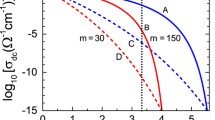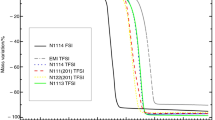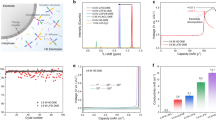Abstract
In many modern technologies (such as batteries and supercapacitors), there is a strong need for redox-stable ionic liquids. Experimentally, the stability of ionic liquids can be quantified by the voltage range over which electron tunneling does not occur, but so far, quantum theory has not been applied systematically to this problem. Here, we report the electrochemical reduction of a series of quaternary ammonium cations in the presence of bis(trifluoromethylsulfonyl)imide (TFSI) anions and use nonadiabatic electron transfer theory to explicate the results. We find that increasing the chain length of the alkyl groups confers improved chemical inertness at all accessible temperatures. Simultaneously, decreasing the symmetry of the quaternary ammonium cations lowers the melting points of the corresponding ionic liquids, in two cases yielding highly inert solvents at room temperature. These are called hexyltriethylammonium TFSI (HTE-TFSI) and butyltrimethylammonium TFSI (BTM-TFSI). Indeed, the latter are two of the most redox-stable solvents in the history of electrochemistry. To gain insight into their properties, very high precision electrical conductivity measurements have been carried out in the range +20 °C to +190 °C. In both cases, the data conform to the Vogel-Tammann-Fulcher (VTF) equation with “six nines” precision (R 2 > 0.999999). The critical temperature for the onset of conductivity coincides with the glass transition temperature T g. This is compelling evidence that ionic liquids are, in fact, softened glasses. Finally, by focusing on the previously unsuspected connection between the molecular degrees of freedom of ionic liquids and their bulk conductivities, we are able to propose a new theory of the glass transition. This should have utility far beyond ionic liquids, in areas as diverse as glassy metals and polymer science.





Similar content being viewed by others
References
Gabriel S, Weiner J (1888) Ueber einige Abkömmlinge des Propylamins. Ber Dtsch Chem Ges 21(2):2669–2679
Plechkova NV, Seddon KR (2008) Applications of ionic liquids in the chemical industry. Chem Soc Rev 37:123–150
Maase M, Massonne K (2005) Biphasic acid scavenging utilizing ionic liquids: the first commercial process with ionic liquids. In: Rogers RD, Seddon KR (eds) Ionic liquids IIIB: fundamentals, progress, challenges, and opportunities. Transformations and processes. Pub: American Chemical Society, Chapter 10, pp 126–132
Mohammad A, Inamuddin (eds) (2012) Green solvents II. Properties and applications of ionic liquids. Springer, Dordrecht
Sheldon R (2001) Catalytic reactions in ionic liquids. Chem Commun 2399–2407
Swatloski RP, Holbrey JD, Rogers RD (2003) Ionic liquids are not always green: hydrolysis of 1-butyl-3-methylimidazolium hexafluorophosphate. Green Chem 5:361–363
Endres F (2010) Physical chemistry of ionic liquids. Phys Chem Chem Phys 12:1648–1648
Katayama Y (2011) General techniques. In: Ohno H (ed) Electrochemical aspects of ionic liquids, 2nd edn. Wiley, Hoboken, pp 33–42
Appetecchi GB, Montanino M, Carewska M, Moreno M, Alessandrini F, Passerini S (2011) Chemical–physical properties of bis(perfluoroalkylsulfonyl)imide-based ionic liquids. Electrochim Acta 56:1300–1307
Vogel H (1921) Das Temperatur-abhängigkeitsgesetz der Viskosität von Flüssigkeiten. Phys Z 22:645–646
Tammann G, Hesse W (1926) Die Abhängigkeit der Viscosität von der Temperatur bei unterkühlten Flüssigkeiten. Z Anorg Allg Chem 156:245–257
Fulcher GS (1925) Analysis of recent measurements of the viscosity of glasses. J Am Ceram Soc 8:339–355
Atkin R, Warr GG (2007) Structure in confined room-temperature ionic liquids. J Phys Chem C 111(13):5162–5168
Mezger M, Schröder H, Reichert H, Schramm S, Okasinski JS, Schöder S, Honkimäki V, Deutsch M, Ocko BM, Ralston J, Rohwerder M, Stratmann M, Dosch H (2008) Molecular layering of fluorinated ionic liquids at a charged sapphire (0001) surface. Science 322:424–428
Waldmann T, Huang H-H, Hoster HE, Höfft O, Endres F, Behm RJ (2011) Imaging an ionic liquid adlayer by scanning tunneling microscopy at the solid|vacuum interface. ChemPhysChem 12:2565–2567
Atkin R, Borisenko N, Drüschler M, El Abedin SZ, Endres F, Hayes R, Huber B, Roling B (2011) An in situ STM/AFM and impedance spectroscopy study of the extremely pure 1-butyl-1-methylpyrrolidinium tris(pentafluoroethyl)trifluorophosphate/Au(111) interface: potential dependent solvation layers and the herringbone reconstruction. Phys Chem Chem Phys 13:6849–6857
Roling B, Drüschler M, Huber B (2012) Slow and fast capacitive process taking place at the ionic liquid/electrode interface. Faraday Discuss 154:303–311
Kilic MS, Bazant MZ, Ajdari A (2007) Steric effects in the dynamics of electrolytes at large applied voltages. I. Double-layer charging. Phys Rev E 75 Article 021502
Fedorov MV, Kornyshev AA (2008) Ionic liquid near a charged wall: structure and capacitance of electrical double layer. J Phys Chem B 112:11868–11872
Paek E, Pak AJ, Hwang GS (2013) A computational study of the interfacial structure and capacitance of graphene in [BMIM][PF6] ionic liquid. J Electrochem Soc 160(1):A1–A10. doi:10.1149/2.019301jes
Chemfiles enabling technologies: ionic liquids (2005) Pub by Sigma-Aldrich Co 5 (6) page 2
Gordon CM, Holbrey JD, Kennedy AR, Seddon KR (1998) Ionic liquid crystals: hexafluorophosphate salts. J Mater Chem 8:2627–2636
Holbrey JD, Seddon KR (1999) The phase behaviour of 1-alkyl-3-methylimidazolium tetrafluoroborates; ionic liquids and ionic liquid crystals. J Chem Soc Dalton Trans 2133–2140. doi:10.1039/A902818H
Binnemans K (2005) Ionic liquid crystals. Chem Rev 105:4148–4204
Mushrush GW, Hazlett RN (1984) Pyrolysis of organic compounds containing long unbranched alkyl groups. Ind Eng Chem Fundam 23:288–294
McNaught AD, Wilkinson A (1997) IUPAC compendium of chemical terminology, 2nd edn. Blackwell, Oxford
Snook GA, Best AS, Pandolfo AG, Hollenkamp AF (2006) Evaluation of a Ag|Ag+ reference electrode for use in room temperature ionic liquids. Electrochem Commun 8(9):1405–1411
Tokuda H, Tsuzuki S, Hasan MAB, Hayamizu SK, Watanabe MJ (2006) How ionic are room-temperature ionic liquids? an indicator of the physicochemical properties. J Phys Chem B 110:19593–19600
Sun J, Forsyth M, MacFarlane DR (1998) Room-temperature molten salts based on the quaternary ammonium ion. J Phys Chem B 102:8858–8864
Buzzeo MC, Hardacre C, Compton RG (2006) Extended electrochemical windows made accessible by room temperature ionic liquid/organic solvent electrolyte systems. Chem Phys Chem 7:176–180
Wei D, Ng TW (2009) Application of novel room temperature ionic liquids in flexible supercapacitors. Electrochem Commun 11:1996–1999
Stewart JJP (1989) Optimization of parameters for semi-empirical methods. I. Method. J Comput Chem 10:209–220
Fletcher S (2010) The theory of electron transfer. J Solid State Electrochem 14:705–739
Levich VG, Dogonadze RR (1959) Theory of non-radiative electronic transitions between ions in solution. Doklady Akad Nauk SSSR Ser Fiz Khim 124:123–126, In Russian
Slater JC (1930) Atomic shielding constants. Phys Rev 36:57–64
Moser CC, Keske JM, Warncke K, Farid RS, Dutton PL (1992) Nature of biological electron-transfer. Nature 355:796–802
Moser CC, Page CC, Farid R, Dutton PL (1995) Biological electron transfer. J Bioenerg Biomembr 27:263–274
Welton T (1999) Room-temperature ionic liquids: solvents for synthesis and catalysis. Chem Rev 99:2071–2083
Holbrey JD, Rogers RD (2008) Physicochemical properties of ionic liquids: melting points and phase diagrams. In: Wasserscheid P, Welton T (eds) Ionic liquids in synthesis, vol 1 Ch 3.1. Wiley, Weinheim, pp 57–71
Vila J, Ginés JP, Pico JM, Franjo C, Jiménez E, Varela LM, Cabeza O (2006) Temperature dependence of the electrical conductivity in EMIM-based ionic liquids: evidence of Vogel-Tammann-Fulcher behavior. Fluid Phase Equilib 242:141–146
Cohen MH, Turnbull D (1964) Metastability of amorphous structures. Nature 203:964
Adam G, Gibbs JH (1965) On the temperature dependence of cooperative relaxation properties in glass-forming liquids. J Chem Phys 43:139–146
Hammond GS (1955) A correlation of reaction rates. J Am Chem Soc 77:334–338
Angell CA, in Rubí J-M, Pérez-Vicente C (eds) (1997) Lecture notes in physics, vol. 492, complex behaviour of glassy systems. Springer, Berlin
Greet RJ, Turnbull D (1967) Glass transition in o-terphenyl. J Chem Phys 46:1243–1251
Debenedetti PG, Stillinger FH (2001) Supercooled liquids and the glass transition. Nature 6825:259–267
Kuboki T, Okuyama T, Ohsaki T, Takami N (2005) Lithium-air batteries using hydrophobic room temperature ionic liquid electrolyte. J Power Sources 146:766–769
Balducci A, Dugas R, Taberna PL, Simon P, Plée D, Mastragostino M, Passerini S (2006) High temperature carbon–carbon supercapacitor using ionic liquid as electrolyte. J Power Sources 165:922–927
Izmailova MY, Rychagov AY, Den'shchikov KK, Vol'fkovich YM, Lozinskaya EI, Shaplov AS (2009) Electrochemical supercapacitor with electrolyte based on an ionic liquid. Russ J Electrochem 45:949–950
Frackowiak E (2006) Supercapacitors based on carbon materials and ionic liquids. J Braz Chem Soc 17:1074–1082
Brennecke JF, Gurkan BE (2010) Ionic liquids for CO2 capture and emission reduction. J Phys Chem Lett 1:3459–3464
Hasib-ur-Rahman M, Siaj M, Larachi F (2010) Ionic liquids for CO2 capture—development and progress. Chem Eng Process 49:313–322
Karadas F, Atilhan M, Aparicio S (2010) Review on the use of ionic liquids (ILs) as alternative fluids for CO2 capture and natural gas sweetening. Energy Fuel 24:5817–5828
Zhang X, Zhang X, Dong H, Zhao Z, Zhang S, Huang Y (2012) Carbon capture with ionic liquids: overview and progress. Energy Environ Sci 5:6668–6681
Kowsari E (2011) Advanced applications of ionic liquids in polymer science. In: Kokorin A (ed) Ionic liquids: applications and perspectives. Pub InTech, Rijeka, Croatia, Chapter 1, pp3–27
Mudring A-V, Alammar T, Bäcker T, Richter K (2009) Nanoparticle synthesis in ionic liquids. In: Plechkova NV, Rogers RD, Seddon KR (eds) Ionic liquids: from knowledge to application. ACS Symposium Series, vol 1030. Pub. by American Chemical Society, Chapter 12, pp 177–188
Nan A, Liebscher J (2011) Ionic liquids as advantageous solvents for preparation of nanostructures. In: Handy S (ed) Applications of ionic liquids in science and technology. Pub InTech, Rijeka, Croatia, Chapter 14, pp 287–301
Tsuda T, Imanishi A, Torimoto T, Kuwabata S (2011) Nanoparticle preparation in room-temperature ionic liquid under vacuum condition. In: Kokorin A (ed) Ionic liquids: theory, properties, new approaches. Pub InTech, Rijeka, Croatia, Chapter 23, pp 549–564
Pinkert A, Marsh KN, Pang S, Staiger MP (2009) Ionic liquids and their interaction with cellulose. Chem Rev 109:6712–6728
Wang H, Gurau G, Rogers RD (2012) Ionic liquid processing of cellulose. Chem Soc Rev 41:1519–1537
Gibril ME (2012) Current status of applications of ionic liquids for cellulose dissolution and modifications: review. Int J Eng Sci Technol 4:3556–3571
Liu Y, Chen J, Li D (2012) Application and perspective of ionic liquids on rare earths green separation. Sep Sci Technol 47:223–232
Glukhov LM, Greish AA, Kustov LM (2009) Electrodeposition of rare earth metals Y, Gd, Yb in ionic liquids. Russ J Phys Chem A 84:104–108
Eßer J, Wasserscheid P, Jess A (2004) Deep desulfurization of oil refinery streams by extraction with ionic liquids. Green Chem 6:316–322
Zhang S, Zhang ZC (2002) Novel properties of ionic liquids in selective sulfur removal from fuels at room temperature. Green Chem 4:376–379
Luo H, Dai S, Bonnesen PV, Buchanan AC (2006) Separation of fission products based on room-temperature ionic liquids. Nuclear Waste Management: accomplishments of the Environmental Management Science Program. ACS symposium series volume 943. Wang PW, Zachry T (eds) Chapter 8, pp 146–160
Valkenburg MEV, Vaughn RL, Williams M, Wilkes JS (2005) Thermochemistry of ionic liquid heat-transfer fluids. Thermochim Acta 425:181–188
Liu H, Maginn E, Visser AE, Bridges NJ, Fox EB (2012) Thermal and transport properties of six ionic liquids: an experimental and molecular dynamics study. Ind Eng Chem Res 51:7242–7254
Palacio M, Bhushan B (2010) A review of ionic liquids for green molecular lubrication in nanotechnology. Tribol Lett 40(2):247–268
Bermúdez M-D, Jiménez A-E, Sanes J, Carrión F-J (2009) Ionic liquids as advanced lubricant fluids. Molecules 14:2888–2908
Doerr N, Gebeshuber IC, Holzer D, Wanzenboeck HD, Ecker A, Pauschitz A, Franek F (2010) Evaluation of ionic liquids as lubricants. J Microengin Nanoelec 1:29–34
Zhou F, Liang Y, Liu W (2009) Ionic liquid lubricants: designed chemistry for engineering applications. Chem Soc Rev 38:2590–2599
Acknowledgments
Dr. Pik Leung Tang is thanked for assistance with DSC measurements. This work was financially supported by Schlumberger WCP Ltd (UK) and EPSRC (UK).
Author information
Authors and Affiliations
Corresponding author
Additional information
Dedication
This study is dedicated to Professor Alexander Milchev on the occasion of his 70th birthday.
Rights and permissions
About this article
Cite this article
Fletcher, S., Black, V.J., Kirkpatrick, I. et al. Quantum design of ionic liquids for extreme chemical inertness and a new theory of the glass transition. J Solid State Electrochem 17, 327–337 (2013). https://doi.org/10.1007/s10008-012-1974-2
Received:
Revised:
Accepted:
Published:
Issue Date:
DOI: https://doi.org/10.1007/s10008-012-1974-2




